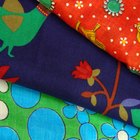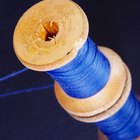
Synthetic fabrics are man-made textiles produced with chemicals. Among these are spandex and polyester, which manufacturers use for making clothing. Spandex materials stretch, while polyester withstands a variety of conditions, making it durable. Some manufacturers add other chemicals to these synthetic fabrics, bringing out other fabric characteristics such as water repelling and stain resistance. You can find both fabrics in retail stores in various colors.
Spandex History
Joseph Shivers, a scientist at DuPont, invented spandex in 1959. DuPont marketed spandex under the brand name Lycra, and sometimes people refer to the material as elastane. The word “spandex” is a play on words based on the notion that the material is “expandable.” Spandex consists of a substance that allows the material to stretch and maintain its shape. Additionally, manufactures blend spandex with other fabrics such as linen, polyester and cotton.
Spandex Applications
Spandex consists of a fiber-forming substance referred to as long-chain synthetic polymer. Once the fabric develops, it is a lightweight comfortable material because of its elasticity and ability to retain its initial shape. DuPont first introduced the world to spandex or Lycra with women’s lingerie and other underwear. Eventually manufacturers expanded the uses of spandex to swimsuits, uniforms and exercise outfits. This synthetic fabric is a frequent option for lifestyle clothing manufacturers.
About Polyester
James Dickson and John Whinfield, both British chemists who worked at Calico Printer’s Association, patented polyethylene terephthalate in 1941. This type of synthetic polymer comes from petroleum, and most people refer to polyethylene terephthalate as polyester. Dickson and Whinfield eventually developed Terylene, making it the first polyester fiber in the world. Both men created polyester based on the nylon inventor Wallace Carother’s research. Eventually, the DuPont company bought the rights to Terylene in the United States and continued researching the polyester fiber, creating its own form, named Darcon, in 1950.
Polyester Applications
In the 1900s plenty of people wore polyester clothing. Even though polyester retained heat and the material was uncomfortable to wear, this type of clothing was inexpensive to make because of the cheap cost of petroleum. The public’s image of polyester from the over-advertisement of cheap suits with large lapels eventually discouraged people from buying polyester clothing. However, polyester started making a comeback with the development of more breathable materials such as microfiber, a wash and go fabric. Other applications that use polyester include wrinkle-free high-end shirts, beddings, costumes, plastic bottles and home decor.
Related Articles

Characteristics of Polyester & Cotton

The History of Flame-Retardant Clothing

How Much of the World's Clothing Is ...

Uses of Cotton Fabric

The Difference in Lycra & Cotton

What Is Pinpoint Cotton?

The Difference Between Polartec and ...

Nomex Vs. Indura Cotton

List of Plants Used for Clothing

What Is Arnel Vintage Material Fabric?

The History of Polyester Fabric

What Is the Difference Between Lycra ...

What Are Psychedelic Clothes?

How to Dye Polyester Fabric

Advantages and Disadvantages of ...

Description and Characteristics of ...

What Is a Synthetic Polyester Fabric?

How to Shrink 100 Percent Cotton Brief ...

Properties of Cotton Fabric

Advantages & Disadvantages of Natural ...